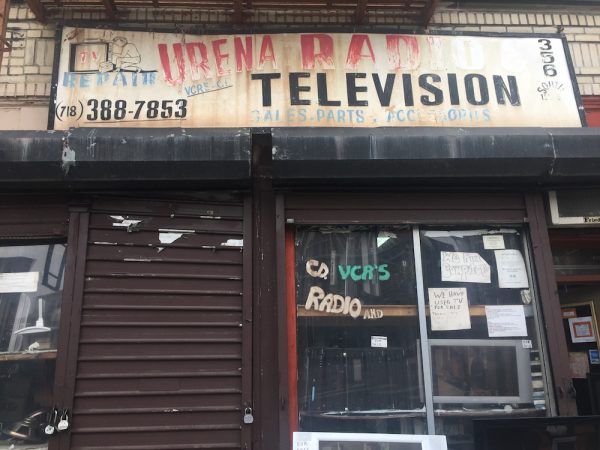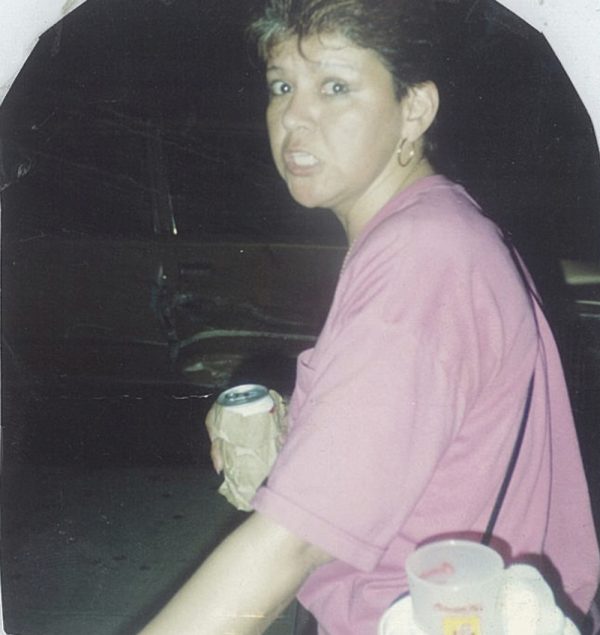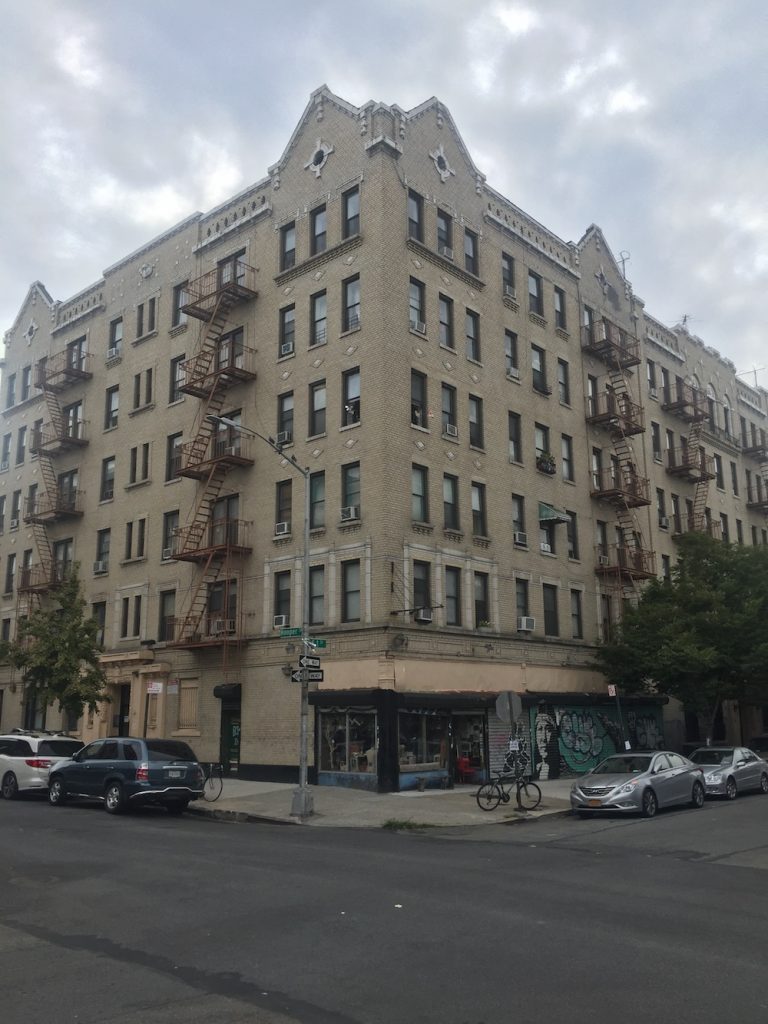“EXTERIORS in the Williamsburg section of Brooklyn are often deceiving.”
— New York Times, “If You’re Thinking of Living in Williamsburg” (June 15, 1986)
*
Drivers traveling west on Grand Street through East Williamsburg know, or come quickly to know, the closest fuel station and the last before entering Los Sures “Southside” Williamsburg onto the Williamsburg Bridge into Manhattan or the Brooklyn-Queens Expressway of the I-278 into Queens is Salerno’s on Maujer Street, but you have to turn south on Lorimer Street. Neighborhood locals, especially the older Puerto Ricans and Hispanics in the southeast, my mother’s generation, may remember more choices beforehand, especially the Shell Oil gasolinera that operated on Borinquen Place when it was ‘Grand Street Extension,’ near Union Avenue to the east and Keap Street and Rodney Street and the Brooklyn-Queens Expressway to the west, from the late 1960s into the mid-1990s. The operation’s duration is astonishing compared to Williamsburg establishments today, where retail and tavern opens, closes and is replaced in a fraction of the time, and this alone warrants study into commerce before and after Williamsburg’s gentrification. Newer residents know the location for the recently built five-story condominium building with penthouse, in varying shades of beige, where one can enroll their child in Tiger Schulman MMA at the Keap Street corner, before dining at Don Pancho Villa near the building’s entrance. The present address is 167-181 Borinquen Place in the 11211, but the city identifies the location on its tax map as Kings County Block 2399.
The L Café near the train station at North 7th and Bedford Avenue in the early 1990s, the Williamsburg Warehouse Events of the mid-1980s to the mid-1990s near Kent Avenue and North 10th Street, the warehouse conversions in the late 2000s to early 2010s along Wythe Avenue from Broadway to North 15th Street, the multitude spaces falling under Loft Law since 1982, the live music shows at McCarren Pool before it was recommissioned for public use in the summer of 2012 or the bomb threats from the neighborhood that preceded its original closing in 1984, the opening of East River State Park, the recent acquisition of Bushwick Inlet Park, the skyscrapers on Kent Avenue and the North Brooklyn waterfront and those waiting to be built, any corner or intersection at any time along retail-rich Manhattan Avenue to the north in Greenpoint or along hip Morgan Avenue and Jefferson Street to the east in Bushwick, all come to mind when mapping North Brooklyn, and for good reason.
North Brooklyn’s history is that rich.
However, social activity in and around apparently quotidian settings like Kings County Block 2399 throughout the 1970s, but especially and perhaps unfairly the real and alleged violence, along similar other locations at the same time across Williamsburg, defined perceptions of crime and deviance in the neighborhood that drove reforms and policy in housing and policing persisting to the present and debated not just t/here in Williamsburg as incumbent Antonio Reynoso and challenger Tommy Torres vie for the 34th City Council district governing Puerto Rican and Hispanic Williamsburg and Bushwick, but all over New York City and State, as well as the nation, indeed, the world over. Block 2399 deserves attention for the domestic and international forces bearing on it that made gentrification possible.
Grand Street travels longitudinal for approximately a mile from Queens where East Williamsburg and Bushwick meet with Ridgewood and Maspeth at the Metropolitan Avenue Bascule Bridge over the English Kills, but branches northeast of Hooper Street, then Borinquen Place begins with Kings County Block 2399, one block east of Rodney Street, between Hewes Street and Keap Street and straddling South 1st Street. The block and street layout of these borders between Los Sures and East Williamsburg is unusual comparing to any location within Williamsburg’s three wards, because Union Avenue united and divided early 19th century Bushwick and Williamsburg, and today’s gentrification contributes to the difference, diversity and incongruity. A 2015 New York University and Department of Transportation study on freight delivery through the neighborhood observed, “East Williamsburg represents a glimpse of what North Brooklyn was prior to the Greenpoint/Williamsburg rezoning in 2005, which connected large swaths of heavy industrial use into residential and mixed-use areas.” Life changes dramatically, phasing through discrete stages of gentrification, crossing Union Avenue south of Grand Street and north of Broadway, according to invisible rules of design.

The former Grand Street Extension united and divided Italians to the north and Puerto Ricans to the south, retail and restaurants to the east on Grand Street, the Brooklyn-Queens Expressway and the Williamsburg Bridge to the west, automobile repair shops to the south, and light-to-heavy manufacturing on either side but especially north. Houses of worship for multiple Christian denominations concentrated nearby on Union Avenue, with an unusual amount of television repair shops almost directly to the south on South 1st Street that have now been replaced, more or less, by tiendas, better known to gentrification as ‘bodegas.’ One of the city’s oldest business improvement districts begins on Grand Street one block to the east, and while retail and restaurants endure, ownership and identity has changed dramatically and inversely, recently and once again. Further east on Grand Street, past Bushwick Avenue and approaching Queens, East Williamsburg is an industrial business zone with powerful business interests protected by the zoning and with its environmental hazards warding off residential development creeping from the Southside, but, truth be told, a similar aura of invincibility surrounded Northside Williamsburg manufacturing not so long ago. Arguments that ‘no one would want to live here’ are echoes, and the lack of desirability for the East Williamsburg IBZ in light of its multiple contamination sites should be measured against the decades of Standard Trust “Greenpoint Oil” and many other polluters spilling into the soil that is foundation for much of today’s luxury condominium developments in the neighborhood, or that Radiac continues operating under and across from Public School 84 Jose Diego School even as Two Trees Management builds luxury condominiums across Kent Avenue.
Fifty summers ago, in 1967, Olga Martinez was the first of my two aunts and seven uncles to move into 388 South 1st Street, a six-story tenement between Union Avenue and Hooper Street, yards from where UnionDocs now operates. “A good place, until—” my mother tells me. New York City was undergoing a population stagnation that lasted into the 1990s when Williamsburg’s gentrification gained mainstream consciousness. Of course, this ‘stagnation’ is relative: Puerto Ricans surged into Williamsburg along with the city while the white population dropped. Shell Oil signed a lease from Metropolitan Playhouses to operate a fuel station on Block 2399 as Salerno’s is opening for business at around the same time two blocks to the southeast on Lorimer Street and Maujer Street. The Shell Oil station operated on Grand Street Extension’s northern side and was conveniently situated for morning traffic. Westbound vehicles entered the station without crossing lanes or opposing traffic, purchased gasoline and then continued on Grand Street Extension to the Williamsburg Bridge and lower Manhattan, or turned right and northwest on Rodney Street to the Cherry Street ramp onto the BQE into Queens. By fueling at Shell Oil than Salerno’s, drivers could travel continuously without diverting from Grand Street onto Lorimer Street and then circling back to the Grand Street Extension. This was especially appealing to drivers of flat-bed and eighteen-wheel trucks. Freight passing through Williamsburg or Greenpoint heading to Manhattan and bound outside the city reaches a significant percentage of the American population within hours. The fuel station was also near the Williamsburg Street ramp south onto Gowanus and heading towards Coney Island, but faced stiff competition from fuel stations near Flushing Avenue. That it was in a better position than any fuel station in North Brooklyn to profit from its location, better even than the Sunoco on McGuiness Boulevard and Meeker Avenue near busy entrance and exit ramps for Queens, was not lost on neighbors, especially the banditos organizing among the Puerto Ricans and Hispanics in and around nearby 388 South 1st Street where we resided. Their interest and activity intensified with the long lines of stalled vehicles waiting at the station when the city rationed gasoline during the OPEC Embargo a few years later.
My mother was the last and tenth of her brothers and sisters to move into 388 South 1st Street. Her explanation is simple and powerful: “We came looking for work.”

Like many blue collar families in overcrowded residences, the Martinezes worked in the neighborhood’s fabricas and handed pay over to Olga, our matriarch and my godmother. She, in turn, sheltered, fed and cared for us, paid our bills and necessities, and functioned like a savings bank or lending institution, disbursing funds negotiated by the entire family. The Martinezes filled and dominated 388 South 1st Street. Across Williamsburg and the city, entire buildings were single households for extended blue collar families. Abuelos lived with you, tías y tíos lived in the floors below and above, and you married into next door or across the street. This type of household anticipated not just the Housing Development Funding Corporation, or “HDFC,” crucial to the rehabilitation of much housing stock in Williamsburg and all over New York City from the late 1970s to the present, but also the practice by more recent entrants into the neighborhood, especially college graduates, renting entire floors or buildings between colleagues than room-mating with strangers.
We watched cinema on Broadway on either side of the BQE-underpass, dined on Chinese-Cuban cuisine at Leon de Oro on Siegel Street, purchased our discount clothing on Graham Avenue, our groceries at any corner tienda, but fresh produce on Grand Street or la Marqueta on Moore Street, and for style we shopped on Delancey Street but especially in the winter we purchased outerwear, our ‘leather,’ on Orchard Street in ‘Loisaida’ or the Lower East Side over the Williamsburg Bridge and west across the East River.
The Diaspora driven to the United States mainland in part by Operation Bootstraps was barely two decades old. The South Bronx and Spanish Harlem may have been cultural centers known to white New York City and America, but Williamsburg’s Puerto Ricans continue to strongly identify with Loisaida. Customs and mores specified to neighborhoods, but the Nuyoricans were united enough that when Esteban de Jesus became the first man to defeat Roberto Duran at Madison Square Garden in a non-title match, the fearsome lightweight champion vowed not to re-match at the center of the boxing universe while it was crowded with Puerto Ricans. My family traveled by train on the Nassau Street Local JJ, now just the ‘J,’ boarding at the Hewes Street or Marcy Avenue stations, but when we crossed the East River to Loisaida, we usually traveled by my mother’s Ford Mustang over the Williamsburg Bridge, and not before re-fueling at Shell Oil on Kings County Block 2399.
It’s now tiresome to explain how the internet has accelerated and simplified research on anything. Data on the geography and sociology of ‘Williamsburg back in the day’ that would have taken hours, if not days, retrieving from some registry buried in a library, municipal archive or museum can be had in ‘real time’ once bookmarking the right websites and belting in Google-fu. It makes so that confusion today over gentrification’s causes in Williamsburg needs its own explanation, seems willful, being less about ignorance than apathy, or measured by academia distant from Williamsburg. Perhaps symbolic of or symptomatic how things are considered, any curious soul beginning with Wikipedia, as many do, will find an omission in the neighborhood’s wiki: beginning with 1972, the history section goes silent. It is also curiously silent about the area before the Dutch acquired the land from the Lenape. The narrative ends with Serpico and resumes, tellingly, with the 2005-rezoning of the Williamsburg and Greenpoint waterfront allowing for skyscrapers of luxury condominium development. This thirty-three year gap has no shortage of persons, organizations and events worth remembering and considering. It was the end of blockbusting, and the time of redlining, benign neglect and municipal disinvestment, of widespread arson and property insurance fraud, but it was also a time of hope and defiance, resistance and sacrifice.

Outside of Williamsburg, this was also the period of conservative backlash across the nation to the Economic Opportunity Act of Lyndon Johnson’s War on Poverty, led by Richard Nixon and targeting especially the Office of Economic Opportunity, which disbursed federal anti-poverty funds to grassroot ‘community action groups’ and ‘VISTA volunteers’ that reached or played some role in the founding and operation of historic North Brooklyn organizations like Brooklyn Legal Services Corporation on Broadway and Havemeyer Street, Los Sures “Southside United” HDFC on South 4th Street directly across where the Brooklyn-Queens Expressway exits onto the Williamsburg Bridge, and the Ridgewood-Bushwick Senior Citizens Council to the east, still operating today. Nixon assigned arch-conservative Howard Philips to head the Office of Economic Opportunity without Senate approval in an obvious ploy at undermining and dismantling the OEO, but the courts ruled against him in 1973’s Williams v. Philips. Americans dismayed by President Trump’s appointment of Scott Pruitt to the Environmental Protection Agency can appreciate the samsara of US politics. This backlash against the War on Poverty was ‘austerity politics’ in New York City. Williamsburg’s gentrification was triggered by this ideological and partisan budgeting, between austerity and anti-poverty, over how federal funds were disbursed on local levels, an untold legacy, perhaps a shadow, of the Civil Rights Movement.
*
This is part one of a 5-part series, T/Here in Williamsburg, that explores the history of gentrification in the Southside of Williamsburg, 1968-1982, through personal and historical narrative.
